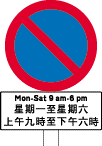On a road without street lighting or a private road:


Where you must not park
You must not park your vehicle:
|
Other than at no-stopping places as described on pages 90 and 91, you may stop to pick up or set down passengers, or load or unload goods - if you can do so without causing obstruction or danger.
You should not stop for longer than necessary to let passengers get on or off. You should only let your vehicle stand for a longer time if loading or unloading of goods is taking place.
Such loading or unloading activities should be carried out as quickly as possible. Your vehicle should not be left unattended or left standing when the loading or unloading of goods has been completed.
|
On a road without street lighting or a private road: |
|
 |
 |
| You must not park at any time on the side of the roadway or on the pavement or verge along that side of the road where there is a single broken yellow line near the edge of the road. | You must not park on the side of the roadway or on the pavement or verge along that side of the road where there is 'No parking' sign at any time, or at the time period shown on the 'Time plate' under the 'No parking' sign. A single broken yellow line may be added on the side of the roadway to indicate the parking restriction. |

Temporary 'No parking' sign - arrows show the direction or directions to which the ban applies
You must not park where there are temporary 'No parking' signs or in a closed or suspended parking space.
Where you should not let your vehicle stand
You should not let your vehicle stand, wait, or load or unload goods where
it would cause danger or inconvenience to other road users, or hold up traffic;
it would cause difficulties for others to see clearly such as in vicinity of junctions or crossings;
it would reduce the width of that part of the road generally used by traffic;
emergency vehicles would stop, or go in or out of premises; and
it would cause danger or inconvenience to pedestrians, particularly where pedestrians are likely to cross the road such as at a pedestrian crossing, at or near a junction or near a traffic island.
|
|||
If your vehicle breaks down, you must not repair, maintain or carry out any works on a vehicle on a road, except for works that are necessary to enable the vehicle to be removed without undue delay. You must not leave a broken down vehicle on a road unattended except while getting help.